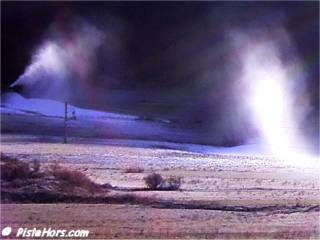The EDF also stocks 315 million m3 of water in the Mont Cenis reservoir in the Maurienne. Sufficient to irrigate 150,000 hectares of pasture for a year. Although rainfall was near normal last winter the Savoie has suffered from four dry years which have exhausted out the aquifers. Rainfall has dropped from an average of 700 mm to 500 mm per year. Local farmers have noticed that springs are slow to start at end of winter and have reduced flow rates. The Maurienne gets tax breaks for developing tourism as part of a Rural Revitalisation Zone (Zone de Revitalisation Rurale - Z.R.R.). Tourist beds have increased from 75,000 to 125,000 over the last decade and many resorts are expanding their ski areas and installing snow making. The need for artificial snow is even greater in the Maurienne as many ski runs are low lying. Farmers are concerned about the future. A recent study by the Savoie County Council (conseil général) claims that haymaking capacity has dropped between 3 and 10 times depending on the area. Hay is used to feed the cattle that supply milk for the local Beaufort cheese. A new study will look at water resources in the area. Albert Tourt, vice president of the farmers association say that everything is linked, water is being over exploited and that a charter of best practise needs to be drawn up between the various interests.
The French Secretary of State for Tourism has called on ski resorts to explore new ideas for the mountain. He thinks tourism should take greater account of the environment and rely less on “white gold” - downhill skiing. Speaking to journalists during the opening of a new weather station on the emblematic Aiguille du Midi at Chamonix he said that “what worked in the past will not necessarily work in the 2015-2020 time-frame, we need new ideas… ski resorts need to face up to reality”. Visitor numbers to ski resorts dropped 7.1% during last winter and numbers are down 10-15% this summer due to the difficult climatic conditions. According to Marc Saddier, who represents 250 French ski resorts, the climate warmed 1.5C during the last century and this has raised the snowline by 250 meters. Every extra degree will see the closure of 100 ski resorts, he claims. Last winter saw the closure of Céüze and Abondance and a financial crisis at Transmontage.
[1]Dry bulb temperatures must be -2 to -4C to make snow, it is possible to make snow around 0C in dry climates.
Posted by
davidof on Tuesday, 24 July, 2007 at 12:56 PM
As an aside Mr Gaymard’s father was a cobbler who made ski boots for the Goitschel sisters. Mr Gaymard had to leave office after it emerged that he was living in a 600 sq m. State apartment in Paris that he had also had redecorated at the tax payer’s expense. He repaid this money after leaving office.
Posted by
davidof on Tuesday, 24 July, 2007 at 01:50 PM
Another aside - the article refers to the recent doubling of the articifial snow production capacity at Les Arcs, but this apparently disproportionate increase in comparison to other resorts is mainly a result of it lagging far behind in terms of acreage covered, simply because the water supply has been insufficient to date. Now a massive new reservoir is planned, increasing overall supply, and as a consequence the demand on current sources will not be greatly affected…
Posted by
Peter Garwood on Wednesday, 25 July, 2007 at 09:19 AM
Maybe the farmers in the Tarentaise Valley need to face upto the fact that their local economy benefits more from skiing than agriculture. Maybe the need to rezone agriculture to just those areas that create high valued added products such as around Beaufort.
I can’t imagine that there are a bunch of unsubsidised farmers there restrained in there expansion plans by a lack of water.
Some ski facilities are obviously subsidised but that is a loss leader to bring in other sales. Cheese tourism is not such a big market.
Posted by on Thursday, 26 July, 2007 at 08:37 PM
That’s a good point, it may be that water is better used to make snow and feed tourists than grow grass. However stopping mountain farming may have unintended consequences. For example ungrazed grassy slopes are more avalanche prone.
Pete is right about les Arcs. I think they only have around 20km of pistes with snowmaking out of some 250. However I seem to remember reading on Pete’s own website that they intend to expand snow making to 50% of the domain in the next decade.
Posted by
davidof on Thursday, 26 July, 2007 at 09:42 PM
Page 1 of 1 pages

